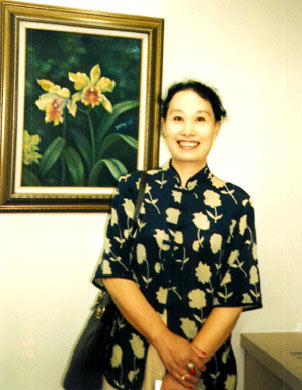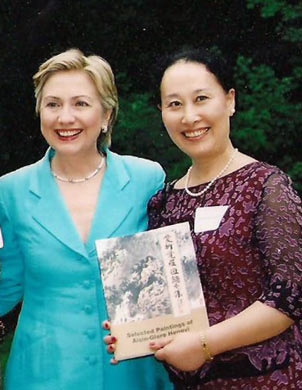



|
A Note From Hengyi
It has been decades since I began my life as a painter, but I have never published any personal album of paintings. This is due to many reasons, but the most important reason is that I have busy trying to press ahead and never even thought of having a look back at the road I have traveled. Recently some friends inspired and even donated their money and find it difficult to say something profound. On second thought, I decide to look back on my decades of experience in Chinese paintings, which maybe a reasonable topic.
I have a rare family background. My ancestor of the fifth generation was an emperor of the Qing Dynasty named Emperor Dao-Guang (Reigned 1821--1851). Before the establishment of the Republic of China, my family inherited the title of The Prince of Dun. The last emperor of the Qing Dynasty, Emperor Xuan-Tong, was my grand uncle. Such a bloodline caused much hardship and ordeal in my life. But at the same time, being raised in a scholar-gentry family, I bred an interest in Chinese art since my early childhood, and immersed myself in the world of Chinese paintings.
First, the famous paintings my family held generation after generation naturally became a silent art teacher for me, inducing me to imitate them one by one in order to find out the secret of Chinese painting. The paintings of Zhu Da were my favorite ones. His birds and flowers were done in vigorous brushwork, and his style was really classic, his brushwork was so easy, full of wit. You admire them, imitate them, and never will you be tired. Shi Tao’s landscape paintings are also the object of my admiration. His paintings are vivid in brushwork, with exquisite style, composed yet full of vigor. I enjoy them, and imitated them, not able to tear myself away from them. Especially his Traveling in Snowy Night, no matter how many times you imitate it, you never feel enough.
In 1959, after release from jail, my grand Uncle Emperor Pu Yi often came to my home to watch me painting. From time to time, he gave me advice. Later my grand uncle Pu Jie introduced me to famous Chinese painters Mr.Hu Shuang-an (Disciple of the late Chinese painting master Zhang Dai-chien), Mr.Qi Liang-chi(Son of the late Chinese painting master Qi Pei-shih) and Mr. Gao Song-lu (Disciple of the late Chinese painting master Wang Xue-Tao), who were so kind as to act as my mentors. Thanks to their untiring guidance, I was introduced into the secret territory of Chinese paintings.
The difficulty in art lies in developing your own new style. To reach this goal, classic painters have found it important to learn from nature by “drafting after all strange peaks and ranges of the mountains.” In order to make good paintings, I also tried to learn from nature and have visited Husshan Mountain, Changbai Mountains, and Helan mountains, traveled the Gobi, and the great deserts, and my footprints covered the whole Yellow Plateau. The Cultural Revolution in 1996 threw me into bottom of human life. For a period of time, my home was almost searched by the Red Guards everyday, sometimes even as many as three times a day. “Difficulties and hardships help one to succeed.” The ordeals of life enabled me to know every aspect of human life, and I begin to know the true meaning of life, which in turn helped to deepen my understanding of the meaning of art. Later, I was sent to the grassland in Inner Mongolia to receive re-education from the farmers as an“educated youth,”where I stayed for more than ten years. Material life was really stark, but the colorful nature made my spiritual life very substantial. To be close to nature every day gave me abundant sources for artistic creation. The golden pheasant seeking food under the verdant bushes, the cranes dancing against the morning sun on the reedy ponds, the touching scene of parent wild geese feeding the young, the colorful wild flowers, the ducks and geese playing around in the rivers, all this gives me artistic inspiration all the time. The life experience of this period bears much upon my artistic life later. Now in my paintings I always aspire for free space and tremendous momentum, this is the aftereffect of my life experience of that time. In order to present the tremendous momentum, I am fond of using bold brushwork and splashing ink effects. I think bold brushwork and splashing ink effects can not only give the paintings majestic momentum and profound meaning, but make the leaves of flowers and trees lively, reposeful and avoid rigidity. At the same time, it is also a test on how I master the secret of the brush and the ink. I am not sure how well I have mastered such techniques, but since the album is before the eyes of the reader now, it is up to the experts to give an assessment.
I owe much to my best friends Ms.Heida Hsieh, Ms.Chen Su-hua, Mr.Zhang Tingchen and Mr.Li Tao for their help that have facilitated the publication of this album. For their profound friendship and help I will always be grateful.
Mr.Wang chi-chien, Mr.Qi Liang-chi and Mr.Han mei-lin each has written a version of the title for this album, and I want to thank them for this. I am also grateful to my mentor Qi Liang-chi who took to write the preface at the age of over eight.
Aisin-Gioro Hengyi; New York
|




